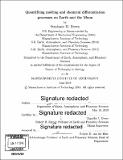Quantifying melting and chemical differentiation processes on Earth and the Moon
Author(s)
Brown, Stephanie Marie,Ph.D.Massachusetts Institute of Technology.
Download1119388735-MIT.pdf (28.18Mb)
Other Contributors
Massachusetts Institute of Technology. Department of Earth, Atmospheric, and Planetary Sciences.
Advisor
Timothy L. Grove.
Terms of use
Metadata
Show full item recordAbstract
This thesis contains four chapters that together investigate the igneous history of the Earth and the Moon. Each chapter explores new quantitative methods for combining experiments in igneous petrology with observed local and global major and trace element compositional variations and geophysical constraints. Integrating all types of geochemical fingerprints and geophysical observations allows us to solve complex natural processes where several interdependent variables are always at play. Chapter 1 investigates the timing and trace element partition coefficient conditions under which the Earth could have crystallized a magma ocean that then overturned and remixed to form an Early Enriched Reservoir and a complementary Early Depleted Reservoir consistent with isotopic measurements of Archean rocks. This study found that Earth most likely last differentiated a highly heterogenous mantle ~40 Ma after Solar System formation. Chapter 2 is an experimental study of the multiple saturation point of the ultramafic Apollo 14 volcanic yellow glasses and their genesis via mixing melts of different lunar magma ocean cumulates. In finding successful mixing scenarios, this study highlighted the importance and possibility of internally consistent petrologic models. Chapters 3 and 4 shift in time from the Hadean and the Archean to the present by focusing on the generation and evolution of mid-ocean ridge basalts. Chapter 3 answers the question "What is the source of the garnet signature in MORB?" by quantifying the permissible range of mantle potential temperatures, mantle compositions, spreading rates, and mantle flow regimes that give rise to recognizable garnet-lherzolite field melting. Chapter 4 applies garnet melting systematics (Chapter 3) and consistency in petrologic models (Chapter 2) to the slow to ultraslow spreading 9-25°E Southwest Indian Ridge. This study found that plagioclase peridotite melting, and not garnet peridotite or pyroxenite melting, of compositionally variable peridotite explains all observed compositional and geophysical variations.
Description
Thesis: Ph. D., Massachusetts Institute of Technology, Department of Earth, Atmospheric, and Planetary Sciences, 2019 Cataloged from PDF version of thesis. Includes bibliographical references.
Date issued
2019Department
Massachusetts Institute of Technology. Department of Earth, Atmospheric, and Planetary SciencesPublisher
Massachusetts Institute of Technology
Keywords
Earth, Atmospheric, and Planetary Sciences.